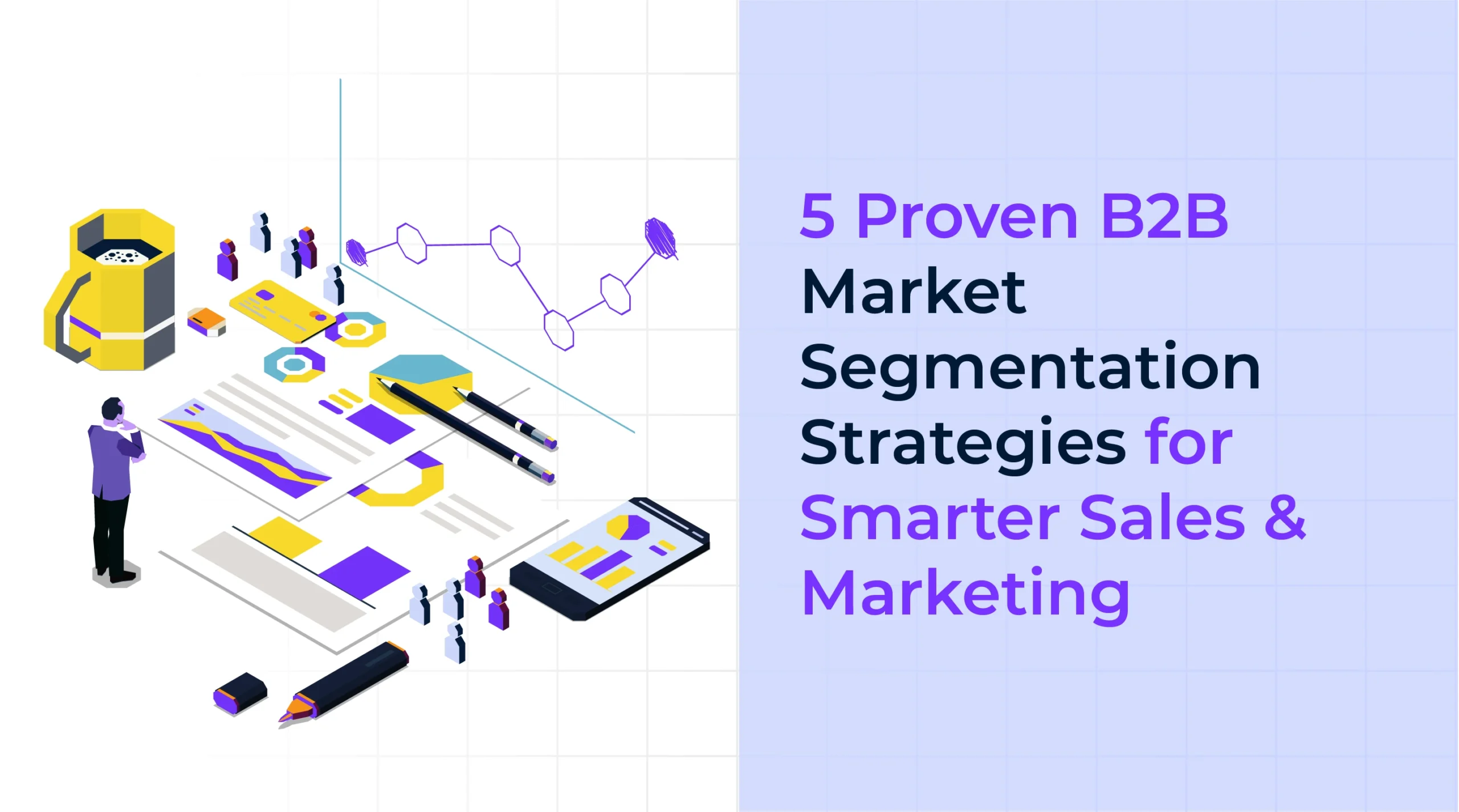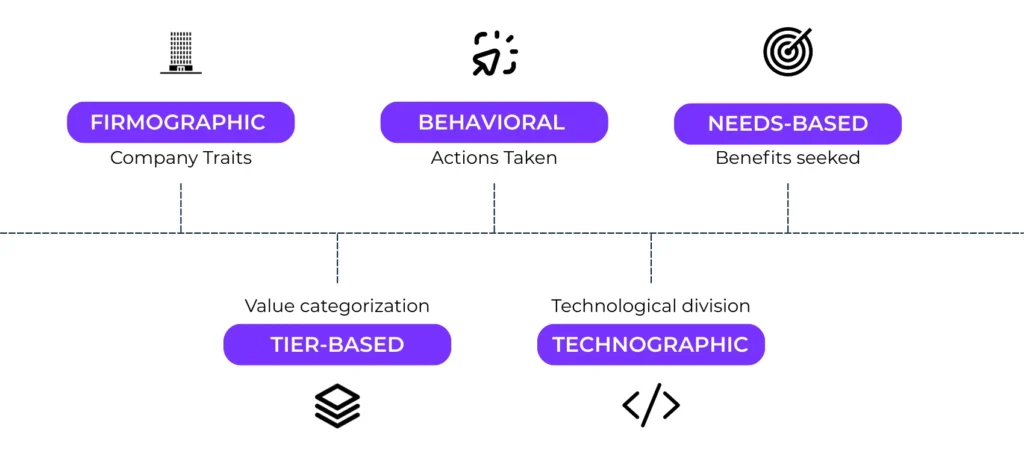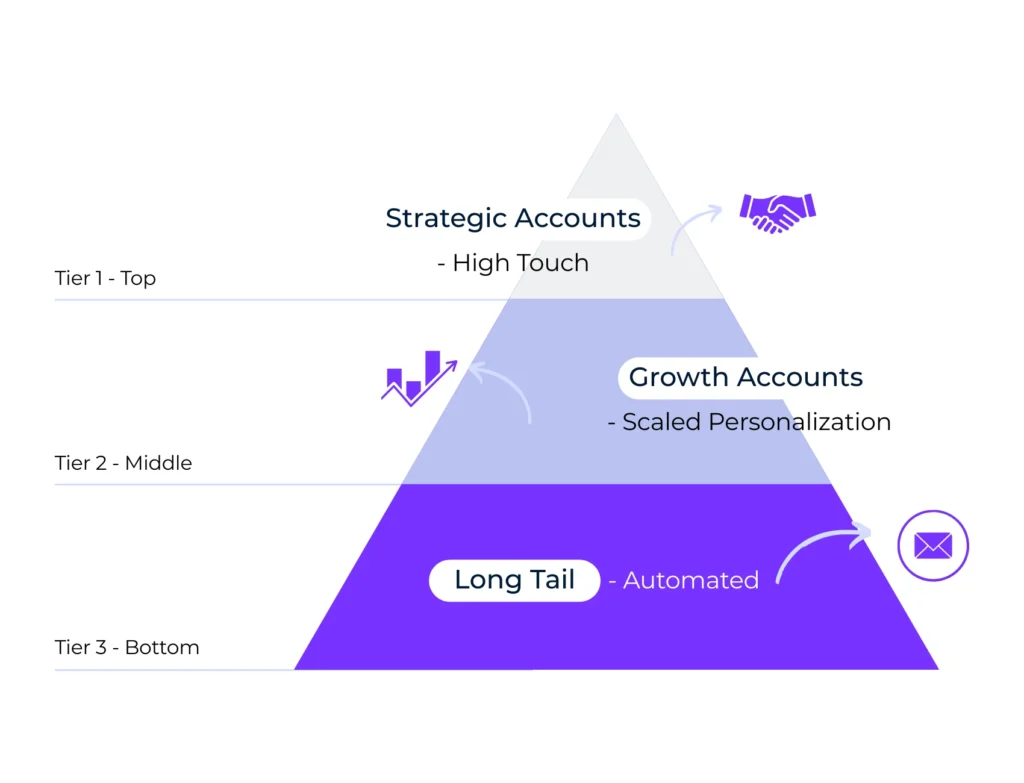
B2B market segmentation is the foundation of any serious marketing and sales strategy. Unlike B2C, where scale allows for broader campaigns and looser targeting, B2B environments demand precision. Decision-making units are more complex, budgets are larger, and you have more to lose. Every bad decision, or misalignment will cost time and credibility.
Precise B2B customer segmentation allows companies to identify patterns in buyer behavior, tailor marketing strategies to those patterns, and align product offerings to real business needs. Ultimately, it’s about understanding what your audience value and how to position yourself as the most logical solution.
By the way, if you’re trying to figure out how you can gather insights to define those segments, check out our guide on Effective B2B Market Research Strategies.
Segmentation is how you move from “spray and pray” tactics to a data-informed, insight-driven B2B marketing strategy. Done right, it increases close rates, improves retention, and raises customer lifetime value by treating different types of business buyers in distinct, relevant ways.
Let’s go through the 5 most effective and often used B2B market segmentation strategies used by your competition. Strategies that they use to beat you at your own game.

Top 5 Effective B2B Market Segmentation Methods
1. Firmographic Segmentation
Firmographic segmentation categorizes companies based on static business characteristics. It’s the fastest way to define broad market segments using accessible, objective data.
Used in:
- Account-based marketing and outbound prospecting
- Building Ideal Customer Profiles (ICPs)
- Territory planning and sales org design
- Top-of-funnel B2B customer segmentation
Why It Matters
Firmographic segmentation gives B2B teams a foundational structure for targeting and qualification. Factors like industry, size, and location often correlate with purchase behavior and solution fit. By narrowing down your market based on this data, you reduce waste and focus resources on accounts most likely to convert and scale.
It also provides a shared language across marketing, sales, and product. Making it easy to align cross-functional teams around the types of businesses they’re best suited to serve. While it lacks nuance, it’s indispensable as a first-pass segmentation layer.

How It’s Used
In practice, firmographics define how lists are built, how outreach is personalized, and how CRM data is segmented. A SaaS company, for instance, might prioritize firms in fast-growing industries with 100–500 employees and a U.S. based HQ. Campaign creatives and messaging are then calibrated to resonate with that segment’s context. This helps in highlighting industry-specific value propositions and use cases. Over time, firmographic segments also inform decisions around expansion, product-market fit, and sales enablement resources.
2. Behavioral Segmentation
Behavioral segmentation groups companies based on what they actually do, rather than what they are. This includes their actions, preferences, and signals of interest. It focuses on observable buyer behavior over time.
Used in:
- Lead scoring and sales prioritization
- Engagement-based campaign automation
- Personalizing website experiences
- Mapping buying stages in segmentation strategies in B2B marketing
Why It Matters

Behavioral segmentation in B2B is critical because activity signals often reveal more than firmographics or self-reported intent. A prospect that visits your pricing page, registers for a webinar, and downloads a case study is communicating urgency and curiosity. And “urgency and curiosity” are two traits your team can act on immediately.
Unlike static criteria, behavioral insights are in motion. They enable in-the-moment adjustments across the sales funnel, surfacing the right leads at the right time with relevant context. This leads to better conversion rates and more productive pipeline conversations.
How It’s Used
Behavioral data helps everything from email nurturing to sales development representative call scripts. When a company repeatedly engages with solution-focused content, it’s often a signal to change from education to conversion. For sales, behaviors such as product trial activity or demo requests are used to prioritize outreach and customize talk tracks. In product-led models, this segmentation continues post-sale, supporting upsell, churn prevention, and onboarding optimization. Behavioral segmentation lets marketing and sales respond to signals.
3. Needs-Based Segmentation
Needs-based segmentation groups buyers by the underlying outcomes or benefits they seek from your product or service. It centers on the “why” behind their purchase decisions.
Used in:
- Creating detailed B2B buyer personas
- Designing differentiated product tiers or pricing
- Messaging and content strategy for specific pain points
- Prioritizing feature development and roadmap decisions
Why It Matters
Unlike firmographic or behavioral models, needs-based segmentation targets motivations. Two identical companies can have radically different priorities: one seeking speed and scalability, the other focused on compliance or integrations. By exposing and clustering these needs, companies can create tighter alignment between marketing, product, and sales motions.
This is particularly powerful in complex buying environments where multi-stakeholder committees weigh different benefits. A CFO’s needs differ from those of a technical lead or operations manager. Understanding and segmenting by those considerations improves messaging precision and deal velocity.
How It’s Used
To apply needs-based segmentation effectively, companies typically conduct interviews, analyze satisfaction data, and use statistical methods like cluster analysis. Once segments are defined, campaigns can be tailored to each segment’s goals. For instance, sending cost-efficiency case studies to “budget-sensitive” segments and roadmap previews to “innovation-hungry” buyers. Product teams use these segments to prioritize feature sets that align with core needs, while sales teams using this intelligence to pitch the right value proposition to each persona. Needs-based segmentation connects what you offer to what buyers truly care about.
4. Tier-Based Segmentation
Tier-based segmentation categorizes accounts based on their strategic and commercial value to your business. Rather than focusing on demographics or behavior, it ranks customers by potential return.
Used in:
- Account prioritization in sales and marketing
- Designing tiered service models and SLAs
- Allocating resources in B2B marketing strategy
- Strategic planning and revenue forecasting
Why It Matters

Not every customer deserves the same level of investment. Some accounts are high-value but resource-intensive. Others may be low-margin but easy to close. Tier-based segmentation helps organizations focus their efforts where they’ll drive the greatest ROI.
This segmentation strategy is particularly relevant in enterprise sales and account-based marketing, where a handful of clients can account for a majority of revenue. It also aligns internal stakeholders – your marketing, sales, customer success and all – on who deserves high-touch engagement versus automated or scaled outreach.
How It’s Used
Tiering is typically built on metrics like customer lifetime value (CLV), win probability, strategic relevance, and cost-to-serve.
High-tier accounts (e.g. Tier 1) receive personalized outreach, dedicated account managers, and bespoke proposals. Mid-tier accounts may get light personalization with templated playbooks.
Lower-tier prospects are often managed through automation, standardized messaging, and self-service tools. Tier-based segmentation allows teams to deliver the right level of effort based on projected return, maximizing efficiency while still optimizing for growth.
5. Technographic & Sophistication-Based Segmentation
This segmentation approach combines two related models: technographic segmentation focuses on the technology stack a company uses; sophistication segmentation assesses how mature or advanced a company is in its workflows, processes, or digital transformation.
Used in:
- Segmenting business markets in SaaS, martech, and IT
- Refining ICPs in competitive tech categories
- Tailoring onboarding and product education
- Prioritizing product roadmap based on adoption readiness
Why It Matters
In high traffic markets, a company’s tech stack or digital maturity level often says more about its fit for your solution than traditional firmographics. For example, a startup using legacy accounting tools might not be ready for an AI-enabled Enterprise Resource Planning system, while a mid-market firm with an advanced stack might be a perfect fit.
Understanding both the tools a company uses and their technical fluency helps you position your solution at the right complexity level. It’s especially valuable when introducing sophisticated products that require process change or integration.
How It’s Used
Technographic data is often collected via third-party tools, website analysis, or direct discovery. It can tell you if a company uses competitor platforms, complementary tools, or old systems. This information is used to configure messaging, showcasing easy integrations or positioning your solution as a next-gen upgrade.
Sophistication-based segmentation usually comes from sales discovery or product usage analysis. It helps define onboarding journeys, support levels, and educational content. For instance, a highly mature prospect may want API documentation and sandbox access. While a less sophisticated one needs guided walkthroughs and hand-holding. Together, these segmentation models allow marketers and sales teams to match the delivery of their value proposition to the buyer’s technical context and maturity level.
Choosing the Right Segmentation Strategy
Align with Business Goals
Every segmentation model must serve a specific function regardless of what you want to do. Whether you’re looking to personalize marketing, improve sales targeting, or refine product-market fit, the segmentation method you choose should directly support those goals. For instance, if your goal is personalized campaign execution, behavioral segmentation in B2B offers more direct and actionable insights than firmographics. If your priority is sales optimization, tier-based segmentation ensures focus on high-value accounts.
The key is to map segmentation methods to business outcomes. Without that alignment, even well-structured segmentation frameworks become disconnected from revenue impact.
Use a Layered Approach
No single segmentation method captures the full complexity of a business buyer. That’s why it is common practice to use a layered model. Combining multiple segmentation criteria in B2B offers a far clearer picture of the buyer journey than any single method.
Starting with firmographic segmentation to define the market, then applying behavioral, needs-based, technographic, and tier-based segmentation to refine messaging, prioritization, and product alignment.
Layered segmentation gives you both scale and depth. You can target broadly while still speaking to the specific motivations, behaviors, and expectations of each segment. It also creates internal clarity, ensuring that marketing, sales, and product teams are aligned on how different types of buyers are approached and served.
Continuously Monitor & Evolve
Segmentation is not a one-time task. Things can change in just a couple of months (in B2B terms that is overnight). What defines a high-value or high-intent segment today might become irrelevant a year from now. That’s why you must continuously monitor the effectiveness of your segmentation method. You may need to use CRM data, campaign analytics, and customer feedback to validate or adjust criteria.
Effective segmentation strategies in B2B marketing are moving systems. They adapt based on performance data, emergent needs, and competitive pressure. The goal is to maintain a responsive model, not apply a perfect one.

Conclusion
B2B market segmentation isn’t just a research exercise. It’s a strategic advantage. Firmographics get you started. Behavioral segmentation in B2B helps you time your messaging. Needs-based segmentation gives you relevance. Tiering adds financial logic, and technographic segmentation ensures technical fit. Each model plays a role, but together, they create a segmentation strategy that drives growth, clarity, and competitive edge.
The most successful B2B organizations revisit and refine their segmentation continuously because markets change, products evolve, and customer behavior shifts. But the goal remains the same: focus on the right customers, with the right offer, at the right time.




